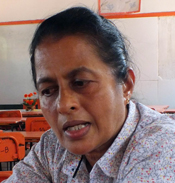A ‘nightingale’ in the FTZ women’s labour force

Ms. Jayanthie Dandeniya Gamage
Free trade zones (FTZs) were a concept created in the mid-1980s to create a new generation of factories for exports.
The early stages of FTZs were considered as somewhat restrictive labour units even though the fact remains that they were able to turn around the rural economy by employing rural young women and the factories earning chunks of foreign exchange.
Trade unions have played a key role in its success, albeit some resistance from factory managements. From the FTZs have also emerged women who have fought to safeguard the rights of workers like Jayanthie Dandeniya Gamage for instance, who has won international fame for her work but lacks local recognition.
Ms. Gamage is the winner of the Women Activist Award from the US in 1996; the Gwangju Prize for Human Rights in 2003, and the Gwangju Democratization Movement and Ashoka Fellowship in 2005. Born on November 7, 1959 at Panamulla, Beliatte, down South, Ms. Gamage is the seventh in a family of 10 children. Her father being a carpenter, she and her siblings had to work hard throughout their childhood to earn money for their schooling and books.
After her schooling she came to Katunayake in 1983 to become a garment factory worker at a time when women were commonly insulted as ‘garment kelli or badu’ and also subjected to immense harassment in their boarding houses and the local community, especially sexual harassment by young men.
She was engaged to Ranjith Herath from another factory who was involved in labour struggles of his co-workers in the factory. Though initially Ms. Gamage did not get fully involved in her fiance’s union work, she was quietly helping him.
Ms. Gamage continued her labour struggle activities and during the height of the 1989 insurgency due to Mr. Herath’s trade union activities in his factory, he was dismissed on August 28, 1989 and an inquiry was fixed for October 26.
But he did not return to the boarding. On August 27, a worried Ms. Gamage went in search of him and got information that Mr. Herath and his lawyer who was to appear at his inquiry had been allegedly shot and murdered and their bodies found burning at the Raddoluwa-Seeduwa junction.
Then she had information that the police and the CID were planning to arrest her. She remembers with heart-felt gratitude that Rev. Sr. Ranjani from a Katunayake convent visited her and accompanied her to the convent and protected her there for two weeks.
Thereafter several social service activists, Catholic priests and nuns headed by Brito Fernando, a Communist Party stalwart, Rev Fr. Sarath Iddamalgoda and Rev. Sr. Christine, moved her from convent to convent and from church to church to save her from arrest.
During the same time one of her brothers was allegedly shot and killed by the armed forces and also another brother went missing, he too allegedly killed by the armed forces.
Ms. Gamage who supported her fiancé in his trade union work since 1983 to 1989, lost her job and she went into hiding for almost four years until 1993.
Though grief and fear gripped her, she started rallying round her colleagues with Rito Fernando and set up a trade union called ‘Kalape Api” (We in the FTZ) and set up a trade union office in the close vicinity of the Katunayake FTZ. Pressure was mounting when the union was set up but they continued dealing with the harassment and abuses perpetrated in the FTZ factories.
They held agitation rallies, protests, demonstrations and sit-in protests and also launched a union-printed publication carrying all the anti-worker activities perpetrated in the factories. This alleged harassment included the notorious ‘Choo Card’ where every worker who uses the toilet had to mark the time they went in and came out, to restrict toilet times for workers.
She was severely injured several times when police baton charged the demonstrations and sit-ins and on two occasions she was bodily thrown into a police jeep, bleeding with head injuries and immediately hospitalised.
Union workers printed leaflets listing their demands and distributed it among the workers in the midst of blockades. The publication ‘Kalape Api’ attacked various factory management that were involved in worker suppression and abuse and its effect was felt when things started changing for the better.
She also became a co-editor of the periodical and likewise they continued their trade union activities in the Katunayake FTZ for more than 20 years, in the midst of major obstacles.
She has been championing the trade union cause not only within the FTZ, but also joining in all the trade union rallies and protests and could be often seen in Colombo with a folded flag in armpit with a long pole walking to the bus terminal in Pettah, after a protest.
Though they did tremendous service to the workers in the FTZ during their trade union existence, they were forced to put up shutters and now Ms. Gamage is involved in counselling prisoners at Bogambara, Negombo and in the Pallansena Open Prison camp through art which she has mastered since her school days.
In Sri Lanka it is very seldom such brave women are found under such trying circumstances and while her bravery in trade union activities and human rights activities has been internationally acclaimed, local appreciation seemed to be lacking.



